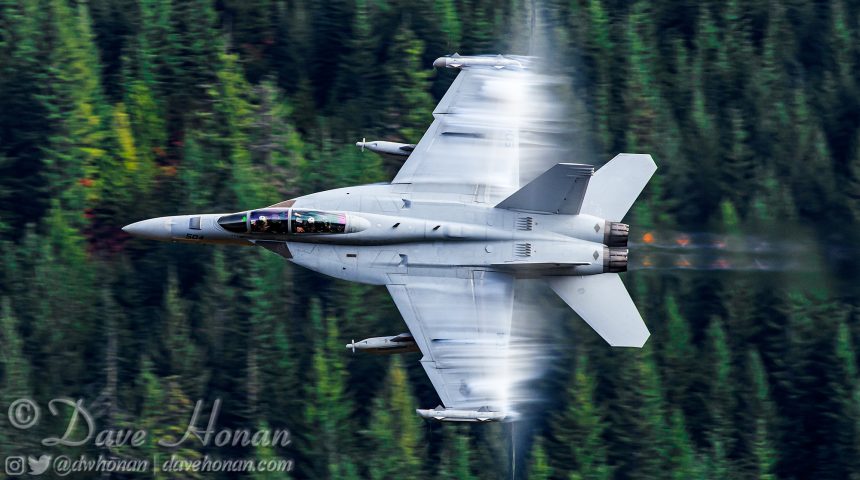Photographer shot an amazing photo of an EA-18G Growler at ultra low level on Visual Route 1355.
The insanely cool photo you can find in this article was taken last month by photographer Dave Honan in the Cascade Mountains of Washington State, in the Pacific Northwest region of the U.S. The image shows a U.S. Navy EA-18G Growler Electronic Attack aircraft belonging to the Electronic Attack Squadron 130 (VAQ-130) “Zappers”, based at Naval Air Station Whidbey Island, Washington, flying low and fast on VR1355, one of the low level routes running through national parks in the Cascade Mountains.
Colloquially called the “million dollar ride” for both the scenic views and the fun and “aggressive” flying that can be done through the valleys, VR-1355 is one of the most popular low level routes among the Growler squadrons based at NASWI.
“I enjoy venturing into the Cascade Mountains in search of jets running the low-level training routes,” Dave said in a message to The Aviationist. “There’s always a high likelihood that I won’t capture anything — the route corridors average ten miles wide — but sometimes I manage to be in the right place at the right time. This particular jet has its afterburners lit, probably to gain energy in preparation for climbing out of the deep valley it’s flying through. That’s relatively rare to see, and makes the image even more dramatic.”
Indeed, the shot, taken with a Canon 1DX MkII with 100-400L MkII lens with 1.4x MkIII extender, is truly amazing.
First of all, the subject and setting are simply great. The Growler is flying with afterburners and visible shock diamonds in the exhaust plume!
Second, the “condensation clouds” around the wings make the shot even more “dynamic”: these are generated by the quick decrease of pressure in the airflow around the wing that brings the water vapour contained in the air to the condensation temperature. It is a rather common phenomenon in high-speed and high-G maneuvers at sea level in moisty weather.
Last but not least, shock waves are clearly visible along the trailing edge axis. Shock waves are generated by the interaction of two bodies of gas at different pressure, with a shock wave propagating into the lower pressure gas and an expansion wave propagating into the higher pressure gas: while the pressure gradient is significant in the transonic region, an aircraft maneuvering at high-speed through the air also creates a pressure gradient that generates shock waves at speed much lower than the speed of sound.
Here’s how I explained the phenomenon commenting the photo of an F-35 flying through the famous Star Wars canyon:
At speed lower than the transonic region, air flows smoothly around the airframe; in the transonic region, airflow begins to reach the speed of sound in localized areas on the aircraft, including the upper surface of the wing and the fuselage: shock waves, generated by pressure gradient resulting from the formation of supersonic flow regions, represent the location where the air moving at supersonic speed transitions to subsonic. When the density of the air changes (in this case as a consequence of shock waves) there is a change in its refractive index, resulting in light distortion.
The light distortion is particularly evident in this crazy cool shot.
A big thank you to Dave Honan for allowing us to post his photographs. Make sure you follow him on Twitter (@DWHonan) and Instagram (@dwhonan) for many more stunning images.









